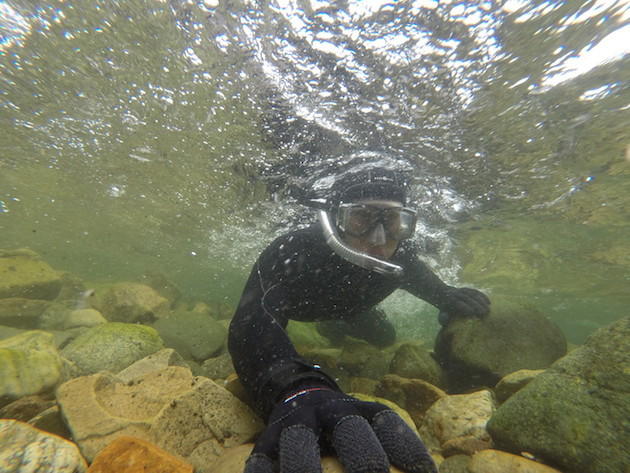Black darkens both sides of the trail I’m hiking. There’s some green on the ground, but not much. Just acres of burned bark, bushes and banks. I’m following researchers into central Idaho’s Salmon River drainage, a wildfire hot zone. The crew is here to count fish; I’m here to see if they find any fish to count.
They visit 33 survey sites in the watershed every summer. They’re looking for native fish, like cutthroat trout, and salmon that travel more than 800 miles from the ocean to spawn in Idaho. The salmon are endangered so the crew counts them without touching them. Snorkeling is how they do it.

“When you’re in some of that really turbulent water, really high-velocity water, it’s trying to rip your mask off your face and rip your snorkel out of your mouth,” says Jordan Messner, Idaho Department of Fish and Game fisheries biologist. “It’ll plug up your ears real quick. It can get pretty loud so we have hand signals we use to relay counts to the data recorder on the bank.”
I’m doubtful there will be any data to record as the wet-suited counters start crawling upstream with their snorkel-covered faces in the water. I settle on my wader-covered knees in the current with a camera on the ready. I have to hold still so I don’t stir up ash ahead of the team. I’m secretly pessimistic as they move single file across the creek in a slow sweep. There’s no way there are freshwater trout in this burn area, let alone saltwater salmon from several states away. A few minutes pass and I think I know it all. Then two hands pop out of the water with eight fingers up. Eight fish swim by. Their fin flips prove I’m wrong and the tally starts running.
“When we get a chance to see these huge adults (Chinook salmon) that are up to 40 inches, it’s pretty spectacular,” says Matt Pumfery, an Idaho Department of Fish and Game fisheries technician. “They’ll swim right up to your face and look at you. It’s like rock climbing in an aquarium.”

I start capturing footage of the underwater rock climbers. Their fingers keep popping out of the water as they count dozens of fish: bull trout, cutthroat trout and salmon. I should know better than to doubt the resilience of the natural world when it comes to recovering from fire.
“You stick your face under water and start crawling up the stream and there’s way more fish in there than you thought,” Messner says. “You can watch them feed a lot of times. Just kind of watch them do their thing.”
They do their thing and I do mine. After an hour, the count on this particular stretch is done. We all get out, dry off, and pack up.
We pass back through the blackened forest in search of another stretch to survey. Fish on, even in off-water.
Photos by Kris Millgate
Subscribe to the free daily newsletter to receive Sporting Classics content directly to your inbox!
Visit the Sporting Classics store for classic hunting and fishing products!

